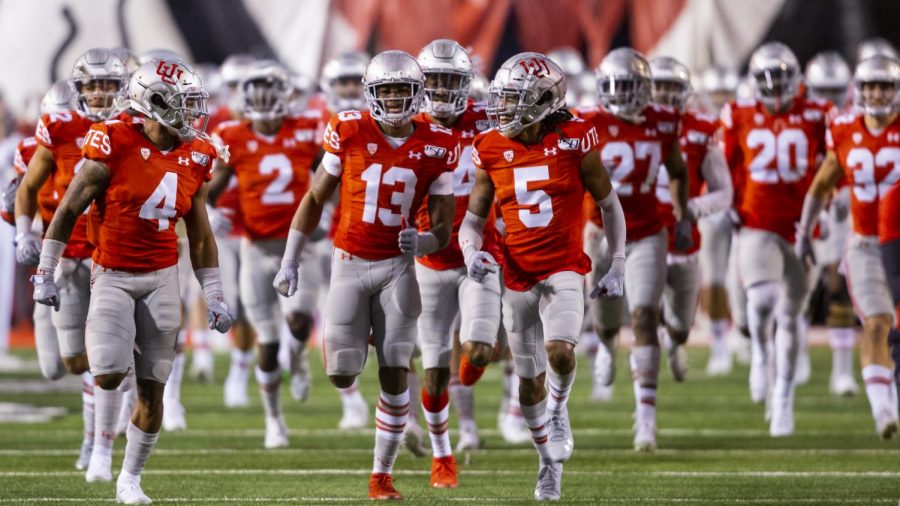Reese: Student-Athletes Should Unionize
The University of Utah Football team rush onto the field prior to the start of the game in an NCAA Football game vs. UCLA at Rice-Eccles Stadium in Salt Lake City, UT on Saturday November 16, 2019.(Photo by Curtis Lin | Daily Utah Chronicle)
August 26, 2020
COVID-19 has lead to canceled and postponed sporting events around the world. With the beginning of autumn, the future of America’s most-watched sport, football, has come into question. The NFL canceled all preseason games and canceling the 2020 season altogether is still on the table. Now American college football conferences are deciding which route to take: postponing until the spring or canceling the season altogether. The University of Utah’s conference, the PAC-12, chose to cancel all fall sports. Amid debate on the college football season, players across the nation are demanding better protection and representation. These athletes’ demands are valid — student-athletes’ labor is consistently exploited by universities and corporations. The logical counteraction to that exploitation is a union to represent student-athletes.
The NFL has a Union, American College Football Should Too
Professional football players in the NFL are members of the National Football League Players Association. This union was formed to force team owners to provide better working conditions such as clean uniforms and safer equipment — basic demands that were not met at the time. The NFLPA continues to fight for better working conditions for professional football players, most recently with the negotiations to hold a season during the 2020 pandemic. Without the NFLPA’s participation, the upcoming season would not have been possible.
With the NFLPA as a template, universities and the NCAA are afraid of student-athletes unionizing because it would institute a fundamental change in the power dynamics between student-athletes and universities. College athletes contribute monetary value far and above their scholarship values — a fact that could be used as a powerful negotiation tool in establishing a union for college athletes. Student-athletes could negotiate for better healthcare and hold coaches and administrators accountable for their actions — as well as fight for racial equality in college sports and in academia.
Student-Athletes are Employees
In 1953, the Colorado Supreme Court ruled in University of Denver v. Nemeth “that Ernest Nemeth, a football player at the University of Denver, was an ‘employee’ within the meaning of the Colorado workers’ compensation statute. Thus, the university was obligated to provide workers’ compensation for his football injuries.” Following this court’s decision, the NCAA instituted the use of the term “student-athlete” in a successful attempt at reframing the public’s perception of college athletics. Defining college athletes as “student-athletes” allowed the NCAA to move away from the notion that these athletes were employees. Despite the NCAA’s clever wordsmithing, the actual job requirements of college athletes did not change.
Student-athletes meet the qualifications of an employee based on the definition in the National Labor Relations Act — “an employee is a person who performs services for another under a contract of hire, subject to the other’s control or right of control, and in return for payment.” Student-athletes are employees. Student-athletes represent universities through athletics most often in exchange for tuition and housing, given as payment in the form of scholarships or grant-in-aid. This relationship then makes the student-athlete financially dependent on their university.
The NCAA and Universities’ Exploit Athletes for Profit
The players of the NFL usually are recruited from college football. College football is very much a feeder system into the NFL. The NCAA says 85% of NFL players in 2019 played for a college team. While a professional football player is more skilled than the average college player, they still are performing the same work that leads to the same outcome — profit. Regardless of skill differences between collegiate and professional athletes, the college sports multi-billion dollar industry is based on the same business principal as the NFL — athletic entertainment monetized through fan attendance, sponsorship, and broadcasting.
Student-athletes spend many hours every week in practice, meetings and games. It is estimated that college football players spend an average of 53 hours a week on football-related activities. For NFL players, their average Monday through Friday is around the same 50-hour mark as a college student. If the NFL players can have a union, college football players and student-athletes have that same right. Without these students playing for the school, the sports-generated profits and income the universities and the NCAA receive would not exist.
Student-Athletes Have a Right to Unionize
The bottom line is that universities and the NCAA are using student-athletes to generate extraordinary revenue — $8.3 billion in the 2018-2019 academic year — on par with the revenue of the NBA. Shamefully, student-athletes receive only a tiny fraction of that revenue while working in a system of curtailed rights and minimal protections.
The beneficiaries of the labor of student-athletes are certainly many — athletic administrators, coaching and support staff and other university employees. Even the general student population indirectly benefits from this labor, due to the increased name recognition of their college or university. It’s time that the athletes behind that labor receive their fair portion of compensation, protections, and rights and only a union can ensure that happens.








